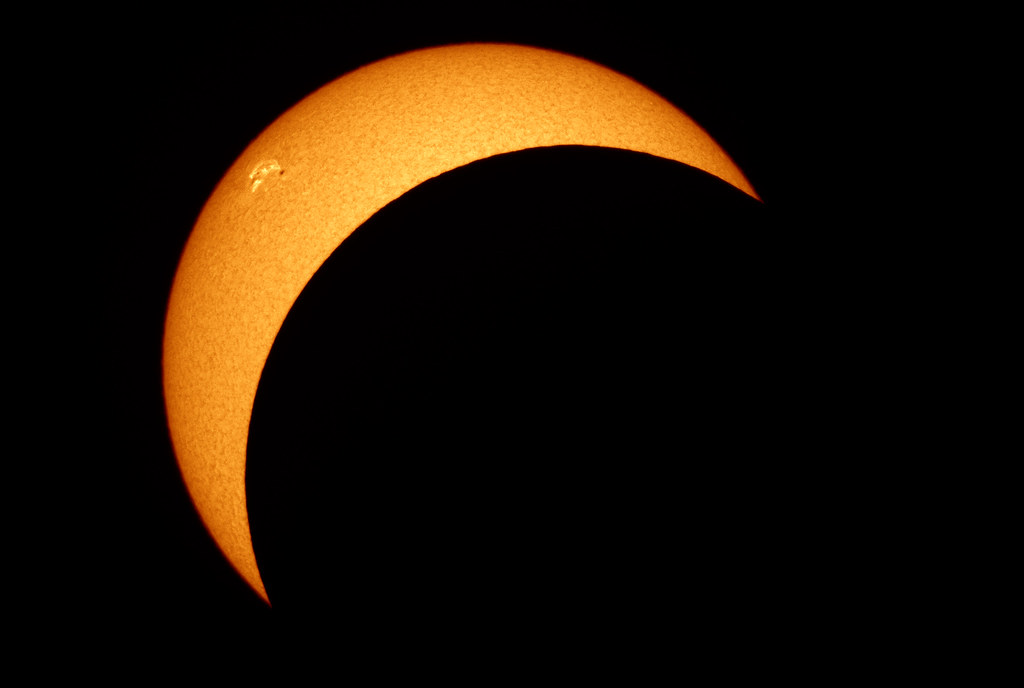
Huntsville, Marshall Preparing to Celebrate Total Solar Eclipse
By Celine Smith
On April 8 between 1 and 3 p.m., the Moon will pass between the Sun and Earth to create a total solar eclipse for 15 states. While Alabama will experience a partial eclipse, area residents can enjoy some fun-filled festivities to celebrate the event.
The U.S. Space & Rocket Center in Huntsville, in collaboration with the Alabama Space Grant Consortium and NASA's Marshall Space Flight Center, will host a family-friendly eclipse watch party. There will be children's activities in the Spark!Lab, starting at 10 a.m. Dennis Gallagher, a plasma physicist within the Heliophysics and Planetary Science branch at Marshall, will give eclipse presentations at 11:30 a.m. and 12:30 p.m. in the National Geographic Theater at the center. Those attending the eclipse watch party will receive a pair of eclipse glasses with their ticket, which is included in the price of general admission to the rocket center. Civil servants can receive free admission for themselves and family members with their ID badge, while Marshall contractors can gain admission with their badge.

Marshall team members don't have to leave the arsenal to enjoy the solar eclipse. Food trucks will be staying at the food corral during the eclipse, so viewers can enjoy lunch while witnessing the natural phenomenon.
Meanwhile, experts from NASA and Marshall have collaborated with the city of Russellville, Arkansas, to provide educational outreach opportunities and panel discussions. The public is invited to this free event, with more than 100,000 tourists expected to visit Russellville for the rare experience.
Due to the length of the eclipse totality in Russellville, NASA is planning to host part of the agency's live television broadcast from the city, as well as conduct several scientific presentations and public events for visitors. There, the total eclipse will last for four minute and 11 seconds.
Everyone is invited to experience the eclipse through NASA's live coverage on NASA+ and the NASA app. NASA also will stream the broadcast live on its Facebook, X, YouTube, and Twitch social media accounts, as well as a telescope-only feed of eclipse views on the NASA TV media channel and YouTube.
Those viewing the eclipse should take proper precautions to protect their eyes. Without protective eyewear during a partial eclipse, viewers are susceptible to eye damage. It's also highly recommended that eclipse viewers wear a hat, use sunscreen, and avoid exposing a lot of skin.
According to Gallagher, the Sun's magnetic field is affected by its rotation. When the Sun rotates enough, the magnetic field can no longer hold its energy releasing solar flares. There are even some instances where bundles of the Sun's magnetic field and ionized gas are ejected together from the Sun's surface, creating a coronal mass ejection. These arches and arcs may be visible during the eclipse.
"Luminous tendrils of ionized gas reaching two to three solar radii in all directions away from the Sun's surface will be revealed in graceful loops and sweeping arches off into the distance," Gallagher said.
"Coronal mass ejections and solar flare emissions are a direct hazard to humans and human made systems. Coronal mass ejections specifically interact with Earth's magnetic field to create additional hazards in space and on Earth's surface. While the Sun seems a steady life-giving companion, uninvolved with Earthly travails, a total solar eclipse offers everyone, including scientists, the chance to get a closer look at what goes on at the Sun behind the blinding glare of its nuclear heart."






